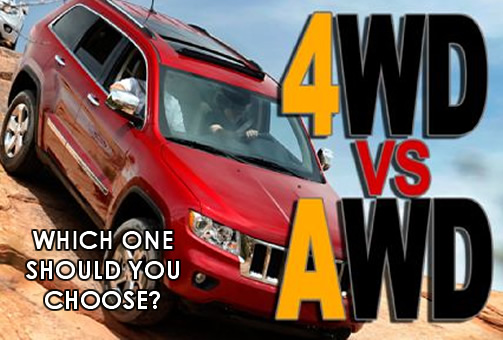
Let’s try and explaining the difference between 4WD & AWD. Most people think driving a 4WD (4×4) vehicle is the same as AWD. However, who can blame them? All-Wheel Drive and Four-Wheel-Drive are both terms that indicate the same thing. In reality though, the way each of these driving systems function are significantly different. Yes, both systems do provide power to all four wheels, but the difference is in the main mechanical semantics. In either case, by purchasing a 4WD or AWD, you leverage stronger and powerful performance. To understand more, let us look at how AWD and 4WD systems work in cars:
All-Wheel-Drive
An AWD system employs center, front, and rear differentials to provide power to all four wheels of vehicle at the same time. They use an electronically controlled clutch or a limited slip differential to allow a rotational difference between rear and front axels. Although these systems have the capability of working beautifully off-road, they really shine during on-road driving (hence, why they are often found in medium-sized SUVs and crossovers).
Some all-wheel-drive systems though are designed to power only two of the wheels and then automatically sense when more power is needed to get the other two working. The key factor is they automatically appropriate torque whenever it is required.
Four-Wheel-Drive (4×4)
4WD systems employ a transfer case and two differentials to provide power to all four wheels. They are normally used in large SUVs, crossovers, and full-sized trucks, designed to use the extra traction of the four-wheels for optimal off-road driving experience. These systems also have a low-range gear ratio for real low-speed, off-road work, and newer vehicle models have a manual switch for you to kick-in the four-wheel drive system whenever needed. 4WD systems’ locked driveline enables vehicle to negotiate difficult terrains during off-road ventures.
The Mechanics
The mechanics of a car’s differential also prove incredibly important for each driving system. In simple words, open differentials enable wheels on the same axle to spin at different rates. This means, during a normal turn, the outside front wheels will get more power as they need to turn more, while the others also receive power but at a different rate. Therefore, AWD is definitely a good technology until one wheel is drowned in mud, while the other is not. 4WD vehicles, on the other hand, use limited-slip differentials to eliminate this problem by sending some power to both wheels.
Regardless of which option you choose, both AWD and 4WD systems accelerate better than front-wheel drive and rear-wheel drive systems in inclement weather, while benefiting from maximum traction and stability. This enables drivers to easily tow from steep or wet road surfaces, while reducing the risk of being stuck. AWD and 4WD systems offer better distribution of torque to all four-wheels. This means, you get better handling and cornering even in the harshest weather conditions, along with improved dry handling.
So, which option should you go for? If you are looking for pure towing and off-road driving, 4WD systems are definitely the right way to go. For normal off-road requirements and remarkable on-road driving, AWD systems are the perfect option.

